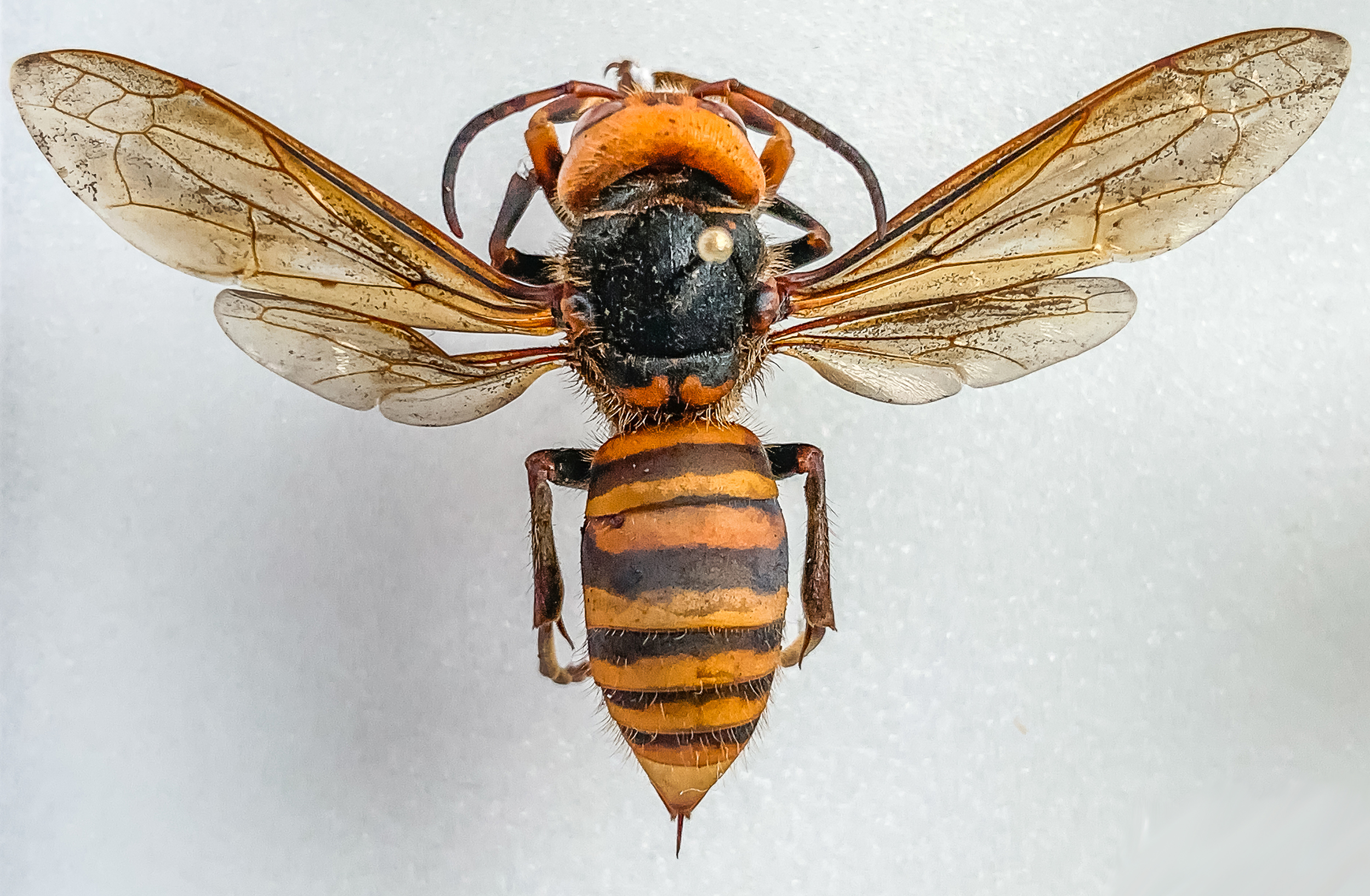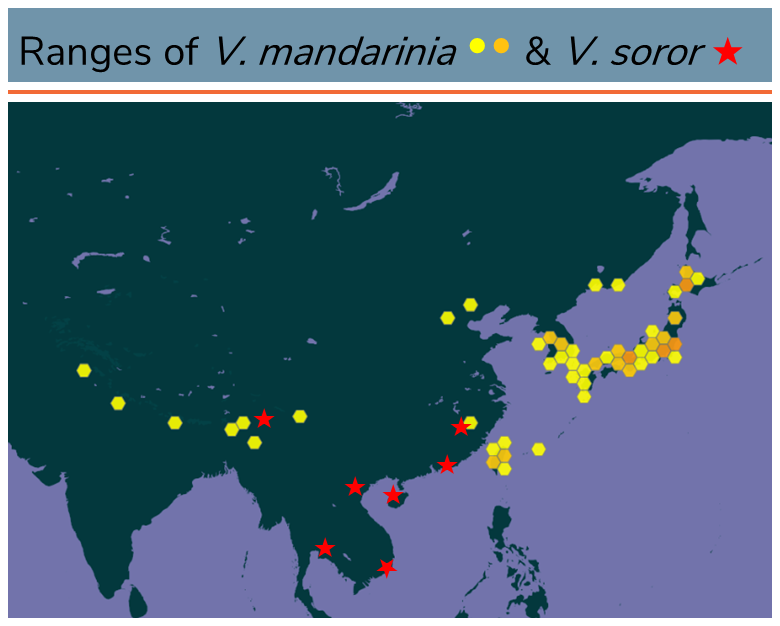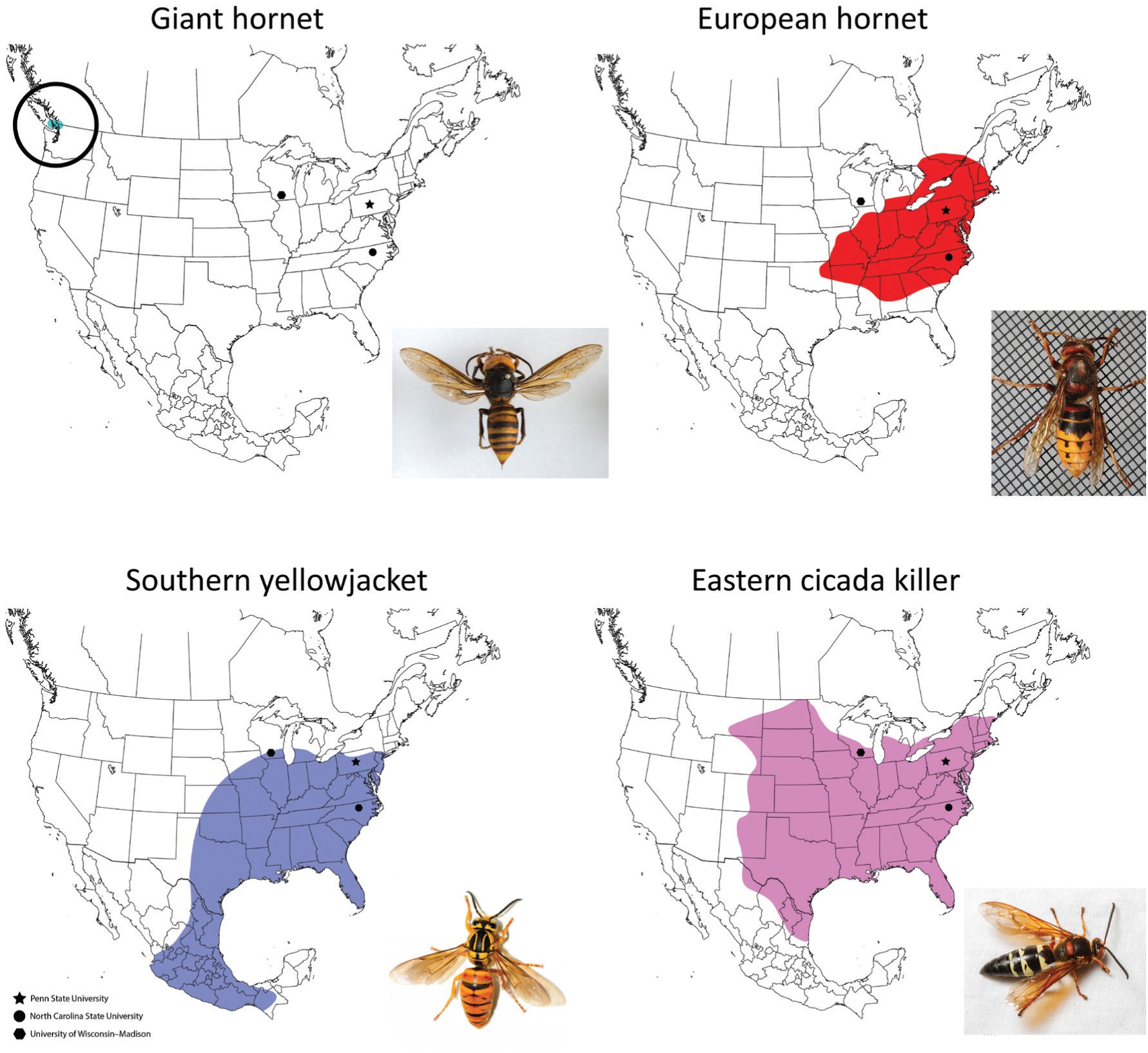Background, FAQs, and More on Common Name Selection for Vespa mandarinia
In July 2022, the Entomological Society of America adopted "northern giant hornet" as the common name for the species Vespa mandarinia in its Common Names of Insects and Related Organisms List.
Vespa mandarinia is an invasive hornet native to Asia that has been the target of eradication efforts in Washington state, USA, and British Columbia, Canada, after individual hornets were first discovered there in 2019. It has been referred to elsewhere as "Asian giant hornet" or "murder hornet."
See ESA press release, "'Northern Giant Hornet' Adopted as Common Name for Vespa mandarinia," July 25, 2022
Why "Northern Giant Hornet"?
In conjunction with "northern giant hornet," ESA also adopted "southern giant hornet" as the common name for the species Vespa soror and "yellow-legged hornet" for Vespa velutina. Vespa soror is a closely related—and similarly large—species to V. mandarinia, and the descriptors "northern" and "southern" refer to the species' native geographic ranges in Asia.
(Range map by Gard W. Otis, Ph.D., University of Guelph; location data from Global Biodiversity Information Facility, gbif.org)
Why Not Other Names Already in Use?
In 2021, ESA adopted new guidelines for its Common Names List, which bar names referring to ethnic or racial groups and names that might stoke fear; the policies also discourage geographic references, particularly for invasive species.
No common name for Vespa mandarinia has been previously adopted by ESA. While "murder hornet" and "Asian giant hornet" have appeared in common usage since 2020, neither meets ESA's guidelines. "Murder hornet" unnecessarily invokes fear and violence, which impede accurate public understanding of the insect and its biology and behavior. While "Asian" on its own is a neutral descriptor, its association with a pest insect that inspires fear and is targeted for eradication may bolster anti-Asian sentiment in some people—at a time when hate crimes and discrimination against people of Asian descent in the United States are on the rise.
Why is the Northern Giant Hornet a Threat?
Northern giant hornets attack and destroy honey bee hives. As the Washington State Department of Agriculture notes, just a few hornets can destroy a hive in mere hours. It also preys on a variety of other insects.
If allowed to establish in regions within North America, the northern giant hornet could significantly impact local ecosystems as well as managed honey bees and the pollination services they provide to agriculture.
Northern giant hornets generally do not attack people, but will do so if provoked or threatened. Their stinger is longer than that of bees and wasps found in North America, and their venom is more toxic.
Transitioning to Northern Giant Hornet: Recommendations
ESA encourages organizations and individuals who work in research or management of Vespa mandarinia (and media outlets communicating about it) to transition to use of "northern giant hornet" in communications, documents, and publications as time and resources allow. Timeframes may differ according to the content type, and a tiered approach may be necessary. For example, websites can generally be updated quickly and at minimal cost, print materials may need to wait until the next print cycle, and regulatory documents may require an extended period to be fully revised.
"Formerly known as ..." It may be necessary to temporarily use "formerly known as Asian giant hornet or murder hornet" to create public awareness of the selection of "northern giant hornet" by ESA. However, ESA urges organizations to move away from any reference to "murder hornet" or "Asian giant hornet" quickly to reduce the potential for invoking undue fear or feeding anti-Asian sentiment. While the exact timeframe might differ by content type and audience, in general ESA would suggest using "formally known as" as needed for the remainder of 2022 and then phasing it out beginning in 2023.
To avoid highlighting the other names in use, ESA suggests including an asterisk (e.g., "The northern giant hornet* is an invasive...") and then placing a brief description at the bottom of the page (e.g., "*Northern giant hornet is the common name approved by the Entomological Society of America for Vespa mandarinia, an invasive hornet native to Asia referred to elsewhere as "Asian giant hornet" or "murder hornet.")
Species Commonly Mistaken for Northern Giant Hornet
In North America, confirmed sightings of the northern giant hornet have been confined to a single county in the state of Washington, USA, and several locations in southern British Columbia, Canada. (See tracking map hosted by Washington State Department of Agriculture.)
However, due to media attention and public interest in the northern giant hornet, several other large wasp species common to other regions of North America have been frequently mistaken for northern giant hornet.
Among these other species are:
- European hornets (Vespa crabro)
- eastern cicada killers (Sphecius speciosus)
- southern yellowjackets (Vespula squamosa)
In the Summer 2022 issue of ESA's American Entomologist magazine, managers of insect-identification labs in Wisconsin, Pennsylvania, and North Carolina documented the significant increase in ID requests for several other wasp species in the months after the northern giant hornet first made headlines.
(Map image from Skvarla et al 2022, American Entomologist)
Elsewhere, northern giant hornet (Vespa mandarinia, at left in the image below) may also be confused with the southern giant hornet (Vespa soror, center) and yellow-legged hornet (Vespa velutina, right), a significant reason why common names for all three have been adopted by ESA concurrently.
Frequently Asked Questions
Why was the name "northern giant hornet" chosen?
The name refers to both the physical size and native geographic range of the species. Vespa mandarinia and the related V. soror are the largest known hornets, or wasps in the genus Vespa. They are, relative to other species in the genus, giants. In its native range in Asia, Vespa mandarinia has been documented in Japan, Korea, and temperate regions of China, where it is the only giant hornet species to occur. Vespa soror, while less researched, is more common in the subtropical lowlands of Asia and appears to completely replace V. mandarinia further south. The adjectives "northern" and "southern" refer to these differences in native ranges.
(Range map by Gard W. Otis, Ph.D., University of Guelph; location data from Global Biodiversity Information Facility, gbif.org)
How was the name reviewed and approved by ESA?
The selection of "northern giant hornet" as the common name for Vespa mandarinia followed the traditional process for all common names adopted for ESA's Common Names of Insects and Related Organisms List.
In April 2022, ESA received a proposal compiled by entomologist Chris Looney, Ph.D., for common names for V. mandarinia, V. soror, and V. velutina. (Read the full common name proposal.) Prior to this, no common names for these species had been approved. The proposal was reviewed by ESA's Committee on Common Names of Insects, which approved the proposal to be advanced for member comment. The proposal was then posted online and shared with ESA members for a 30-day comment period. Submitted comments were reviewed by the Common Names Committee, resulting in no changes to the proposal. The committee then submitted the proposed names to the ESA Governing Board for final review and approval, which took place June 30, 2022.
Why didn't ESA adopt the other names already commonly used?
In 2021, ESA adopted new guidelines for its Common Names List, which bar names referring to ethnic or racial groups and names that might stoke fear; the policies also discourage geographic references, particularly for invasive species.
No common name for Vespa mandarinia has been previously adopted by ESA. While "murder hornet" and "Asian giant hornet" have appeared in common usage since 2020, neither meets ESA's guidelines. "Murder hornet" unnecessarily invokes fear and violence, which impede accurate public understanding of the insect and its biology and behavior. While "Asian" on its own is a neutral descriptor, its association with a pest insect that inspires fear and is targeted for eradication may bolster anti-Asian sentiment in some people—at a time when hate crimes and discrimination against people of Asian descent in the United States are on the rise.
Why does ESA get to choose the name?
The ESA Common Names of Insects and Related Organisms List was created in the early 20th century to improve communication between the scientific community and the public and has grown to recognize common names for more than 2,300 insect and arthropod species.
ESA adheres to the list in its scientific journals, conferences, website, social media, and public policy documents. ESA also makes the common names list available as a public resource, and a variety of scientific organizations, extension professionals, and media outlets refer to it.
Where does the name apply?
ESA's list of common names reflects common names in the United States. Other countries and communities often have their own unique common names for insects. This common name selection applies to use in the United States. In addition, the Entomological Society of Canada has also approved "northern giant hornet" (and "frelon géant du nord" in French) for Vespa mandarinia and "southern giant hornet" ("frelon géant du sud" in French) for Vespa soror in its common names list.
Why are three hornet species being named at once?
Vespa mandarinia, Vespa soror, and Vespa velutina have all been referred to with similar common names in existing literature, so distinct common names have been adopted for all three to avoid confusion among them. Previously, both V. mandarinia and V. soror have been referred to as "Asian giant hornet" or just "giant hornet," and V. velutina has often been called "Asian hornet" where it has been introduced in Europe. (In fact, in his proposal for these new common names, WSDA entomologist Chris Looney, Ph.D., notes: "We know that at least one report of V. mandarinia in Washington State was submitted to a UK agency instead of WSDA, the submitter becoming misdirected precisely because the names 'Asian hornet' and 'Asian giant hornet' are so similar. This likely caused a two-month delay in locating and eradicating the colony removed in 2020.") Thus, the names "northern giant hornet" (Vespa mandarinia), "southern giant hornet" (Vespa soror), and "yellow-legged hornet" (Vespa velutina) will allow for clear differentiation among the three species.
Why not also rename the European hornet (Vespa crabro)?
The species Vespa mandarinia, Vespa soror, and Vespa velutina had no existing names previously adopted in ESA's Common Names of Insects and Related Organisms List. By contrast, the common name "European hornet" for the species Vespa crabro has been in ESA's Common Names list for decades.
With popular interest in V. mandarinia, V. soror, and V. velutina relatively new but growing rapidly, adopting common names for them now is essential. "European hornet" may be a candidate for a future name change via ESA's Better Common Names Project, the volunteer group tasked with considering changes to existing names, but no decision has yet been made. Replacing a long-established name presents a different set of challenges compared to adopting common names for insects with no previously approved name.
More Info on Northern Giant Hornet
Listed below are several resources for learning more about the northern giant hornet, Vespa mandarinia. (Note: Several of these resources have not yet transitioned to use of "northern giant hornet," and those from periodicals published prior to July 2022 likely will be left unchanged.)
- Washington State Department of Agriculture
- Washington Invasive Species Council
- Invasive Species Council of British Columbia
- Animal and Plant Health Inspection Service, U.S. Department of Agriculture
- Global Biodiversity Information Facility
- Center for Invasive Species and Ecosystem Health
- "New Honey Bee Pests in North America," by Paul Kozak and Gard Otis, Bee Culture, August 1, 2020
- "When catchy names for insects sting — think ‘Asian giant hornet’," by Hannah Weinberger, Crosscut, September 10, 2021
- Recent publications in Entomological Society of America journals:
- "Risk Assessment for the Establishment of Vespa mandarinia (Hymenoptera: Vespidae) in the Pacific Northwest, United States," by Erik D. Norderud, Scott L. Powell, and Robert K. D. Peterson, Journal of Insect Science, Volume 21, Issue 4, July 2021
- "First Reports of Vespa mandarinia (Hymenoptera: Vespidae) in North America Represent Two Separate Maternal Lineages in Washington State, United States, and British Columbia, Canada," by Telissa M. Wilson, Junichi Takahashi, Sven-Erik Spichiger, Iksoo Kim, and Paul van Westendorp, Annals of the Entomological Society of America, Volume 113, Issue 6, November 2020
- "The Diversity of Hornets in the Genus Vespa (Hymenoptera: Vespidae; Vespinae), Their Importance and Interceptions in the United States," by Allan H. Smith-Pardo, James M. Carpenter, and Lynn Kimsey, Insect Systematics and Diversity, Volume 4, Issue 3, May 2020
IMAGES:
- Northern giant hornet, dorsal view, Karla Salp, Washington State Department of Agriculture, Bugwood.org
- Asia range map for northern giant hornet (Vespa mandarinia) and southern giant hornet (Vespa soror), Gard W. Otis, Ph.D., University of Guelph; location data from Global Biodiversity Information Facility, gbif.org
- North America range map for four hornet species, Skvarla et al 2022, American Entomologist
- Northern giant hornet, lateral view, Allan Smith-Pardo, Invasive Hornets, USDA APHIS PPQ, Bugwood.org
- Southern giant hornet, lateral view, Allan Smith-Pardo, Invasive Hornets, USDA APHIS PPQ, Bugwood.org
- Yellow-legged hornet, lateral view, Allan Smith-Pardo, Invasive Hornets, USDA APHIS PPQ, Bugwood.org




